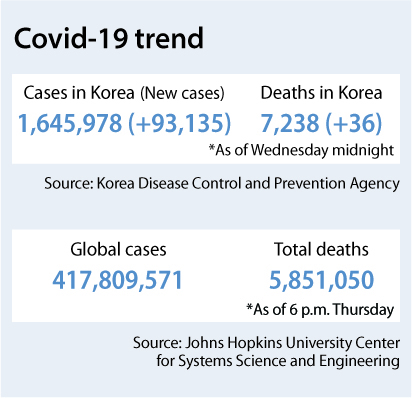Crest of Korea's Omicron wave not yet in sight
![A staffer at a Covid-19 screening center in Gwangju warms his hand in front of a heater on Thursday amid a cold spell. [YONHAP]](https://koreajoongangdaily.joins.com/data/photo/2022/02/17/aa3fc1ac-3123-4822-880d-76c5e2d4c2dc.jpg)
A staffer at a Covid-19 screening center in Gwangju warms his hand in front of a heater on Thursday amid a cold spell. [YONHAP]
Korea's Omicron wave continues to build and health authorities confessed Thursday that they don't know when it will crest — and start to subside.
“After gathering predictions from various researchers, we have made a prediction that daily Covid-19 cases could increase from 130,000 to 170,000 by the end of February,” said Lim Sook-young, director of the Infectious Disease Crisis Response Bureau at the Central Disease Control Headquarters, during a press briefing Thursday.
“There is difficulty in predicting the exact timing of the wave’s peak or its size,” Lim said.
Lim explained the difference in public health measures instituted in Korea and places overseas such as Europe, where cases are sliding.
“Overseas countries were very fast in reaching their peak, while in Korea, it is taking about twice as long due to reasons such as the implementation of the 3T strategy,” Lim said.
Korea’s 3T formula refers to testing, tracing and treatment, which was the main pandemic strategy implemented during the Delta variant's dominance, when cases were generally more severe and transmission slower than with Omicron.
“We believe the 3T strategy helped to stably manage the current curve of the wave,” she added.
Another factor is the difference in the spread of the disease — the number of infected people compared to the total population, Lim said.
“Since foreign countries already had many infections, there were more people achieving natural immunity,” Lim said. “Because Korea’s scale of infection wasn’t that big, there were fewer people getting natural immunity.”
Korea hit another record number of daily Covid-19 infections Thursday, 93,135, raising the total caseload to 1,645,978, according to the Korea Disease Control and Prevention Agency (KDCA). All but 90 were locally transmitted.
Thursday’s figure rose by 2,692 from the previous day’s record of 90,443 cases.
The number of Covid-19 patients in critical condition jumped by 76 from the previous day, hitting 389 as of Thursday. The figure, which remained in the 200s from late January, rose above 300 on Feb. 14 and is now approaching 400.
Thirty-six more people died of the virus, bringing the death toll to 7,238.
Despite signs of an upward trend in critical cases, authorities believe critical patients are rising relatively slowly compared to infections — and also compared to other countries abroad.
“In Korea, people over 59 have very high participation in booster vaccinations, with 87.3 percent of that age group having received a booster shot,” said health official Lim. “This is a fairly high number compared to other countries, which we believe have contributed to reducing hospitalizations.”

“We have strengthened virus measures at [elderly-care facilities] and maintained the regular preemptive testing policy,” Lim said, adding the public’s active participation in mask wearing and social distancing is another factor.
Still, the government is warning of increases in critical cases and fatalities.
Although health authorities were cautious about predicting when the Omicron wave will peak, a state-run thinktank forecast that the current wave will peak at 270,000 daily cases next month.
Mathematics Professor Shim Eun-ha of Soongsil University, who studies and predicts Covid-19 spread at the National Institute for Mathematical Sciences (NIMS), said in a radio interview on Thursday that the peak may arrive “around mid-March” with “270,000 cases” according to her mathematical modeling.
KDCA commissioner Jeong Eun-kyeong had predicted that new Covid-19 patients could possibly reach between 130,000 and 170,000 at the end of February.
In a report released earlier on Feb. 9, the NIMS predicted that the number of critical patients could reach 3,000 in early March, given that the severity of Omicron is reduced by 74 percent from Delta. This is twice the medical capacity that the country can handle, which is 1,500 patients.
Health authorities are set to announce a new set of social distancing measures on Friday.
BY SEO JI-EUN [seo.jieun1@joongang.co.kr]










with the Korea JoongAng Daily
To write comments, please log in to one of the accounts.
Standards Board Policy (0/250자)